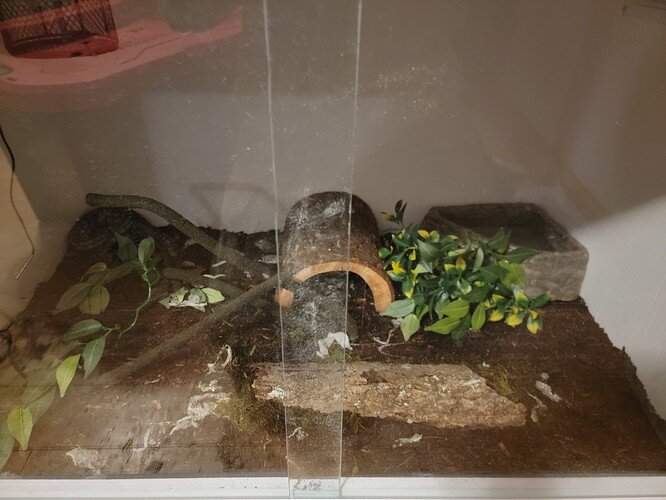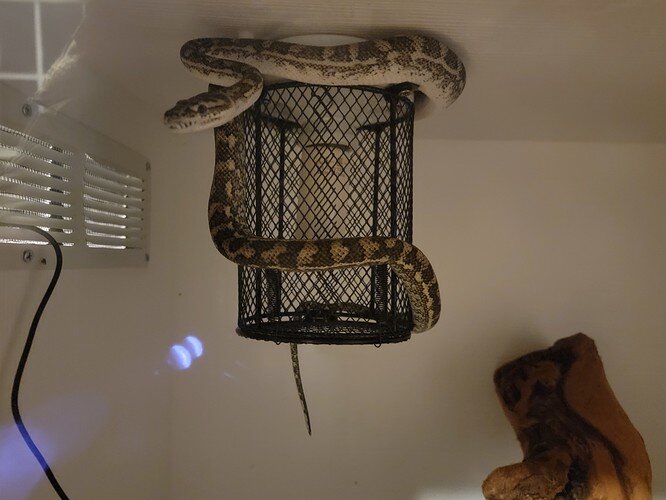So for anyone thats been following along, youve likely seen my talk of the comparison between my enclosures that are bioactive with springtails vs my enclosures i field stripped and treated every 3 days. The difference has so far been night and day. My 16 tub ARS rack has arrived and it gives me the perfect opportunity for an experiment. I am going to move my snakes 1 by 1 to the new snake room as the tubs reach maturity (a healthy established colony of springtails). I have just moved the second
snake up to one of my new 3x2x2s that i have in that room that ive hsd growing a colony for a couple weeks. This snake was infested as of 4 days ago. I gave it a treatment 4 days ago and yesterday of reptile spray. I also just helped her shed, which removed most mites from her, except for any especially sneaky ones. I will try to move each one directly after a shed, to reduce the amount of starting mites.
Obviously for the safety of the snakes this isnt a true scientific experiment, there are no “control” untreated snakes (except for the original bioactive ones that never got hit). All snakes not in bioactive will be treated, and they will be thoroughly cleaned before moving up to the other room as best as possible, so there are many factors at play besides just bioactive. But so far reptile spray has been good at keeping numbers down and treating infested snakes, ivermectin has been useless, but the snakes that have remained untouched are those kept with springtails. So i figure this is worth experimenting with.
Should this experiment fail, it also leaves me the option to purchase predator mites, which will work against the snake mites, and should reach an equilibrium with my springtails afterwards. Will update as this progresses. So far mite infected snakes 22ish (the 3 scaleless have a mite or two, but are mostly unaffected due to no scales), unaffected snakes 5 (1 that is my pet and was never exposed to the other snakes, 3 that were on bioactive, and 1 that recovered when switched to bioactive.)
5 Likes
And this is why you always test heat guards with your hands prior to allowing your snake into an enclosure. They can and will wrap around them.
I have tested this heat guard and the coating only allows the guard to get to luke warm temperature, it dissipates well. If you buy the cheap bare steel versions, the light or CHE may just heat them up to the same temp as the bulb and you get an equally burned snake. When you only have a couple enclosures i recommend not even having the CHE in the enclosure to begin with.
2 Likes
Quick update. I believe ive solved part of the mystery!
So today, i decided to take a long hard look into my colony tub that my springtails originated from. Much to my surprise, when i look REALLY close, i saw little red/orange mites in there.
For those unfamiliar, there is one main mite type that has the redish orange coloration that would thrive in a box full of springtails.
If you guessed predator mites, congratulations, youve won the prize! I had not even thought to look hard enough to see them until i was inspecting a shipment of isopods and found a single pred mite in the cup one of them came in. Once i saw the hitchhiker it got me wondering whether there was a possibility ive had such hitchikers before, and sure enough, it seems a small colony is active in my colony bin.
Now, i havent seen any evidence of them outside the colony bin, i.e. in the bioactive enclosures, but if they are in the colony bin, i figured its a fairly safe bet they would be more than capable of migration like the springtails, and with the snake mites being unable to thrive in my bioactive enclosure, between the springtails going after the eggs and the pred mites going after the adults, it makes complete sense the snake mites are dieing off whenever i put a snake into bioactive.
I definitely think the springtails help, but i cannot do a good experiment to see how much because the pred mites influence the results, and im certainly not gonna stop the pred mites from helping me out.
So, long story short, happy day, i accidentally got predator mites without noticing and they are doing well!
5 Likes
So now for the downside. The feeling where you see a turf war going on and are not sure who is on your side. I believe the orange mites to be predatory mites that are actively trying to hunt the remaining snake mites. However, there is always that little hand of doubt if what if its just baby snake mites. However, from what ive seen, the baby snake mites are just small and grey (at least the species that is on my animals). Its just nerve wracking seeing so many mites, but the snake mites are far outnumbered, ans i see none of the orange mites latching on. Instead, they go under each scale, then back out, and repeat, i assume looking for easy pickings as i imagine latched on snake mites dont really run from them.
1 Like
I hear you.
Predatory mites are, generally, much more active and fast moving than snake mites.
1 Like
Oh yeah, they are cruising over the snake in and out of scales searching. The snake mites are just crawling.
Just checked that same snake today, both mite types arent there in any large quantity (by this i mean i see none, but that doesnt mean there is none). Also the swelling around his eyes is going down, so my guess was it was a wave of hatching reptile mites that caused the predator mites the flourish, and now that they got the mites on the snake, they are hunting in the substrate again.




